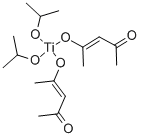TITANIUM HYDRIDE
Synonym(s):Titanium hydride
- CAS NO.:7704-98-5
- Empirical Formula: H2Ti
- Molecular Weight: 49.88
- MDL number: MFCD00151301
- EINECS: 231-726-8
- SAFETY DATA SHEET (SDS)
- Update Date: 2025-01-27 09:38:02

What is TITANIUM HYDRIDE?
Chemical properties
grey to black powder
Chemical properties
Titanium Hydride, TiH2, is a brittle, metallic-gray solid, density 3.8 g/cm3, which produces 448 mL H2 at STP per gram TiH2. Titanium hydride powder is stable at room temperature and inert to water and most chemical reagents. Titanium hydride is used as a source for Ti powder, alloys, and coatings; as a getter in vacuum systems and electronic tubes; as a sealer of metals; and as a hydrogen source.
Physical properties
Grayish-black metallic powder; stable in air; density 3.75 g/cm3; decomposes at 450°C with evolution of hydrogen; insoluble in water.
The Uses of TITANIUM HYDRIDE
Additive in powder metallurgy; getter for oxygen and nitrogen in electronic tubes; wetting agent for ceramic to metal seals; source of pure hydrogen.
The Uses of TITANIUM HYDRIDE
Titanium(II) hydride is widely utilized as an additive in the manufacturing of Alnico sintered magnets and in sintered powdered metals. It is used in the production of metal foam, powdered titanium metal and in pyrotechnics. It is involved in various applications such as ceramics, pyrotechnics and sports equipment. It is also used as a laboratory reagent and as a blowing agent.
Preparation
Titanium hydride is prepared by heating titanium dioxide with calcium hydride at 600°C in the presence of hydrogen
Also, the hydride may be prepared by heating tianium metal with hydrogen at elevated temperatures.
General Description
A white to light colored solid. Insoluble in water and denser than water. Contact may irritate skin, eyes and mucous membranes. May be toxic by ingestion. May ignite and burn with an intense flame if exposed to high temperatures or flame.
Air & Water Reactions
Highly flammable. Pyrophoric in dust form [Bretherick 1979. p. 104]. Insoluble in water.
Reactivity Profile
Hydrides, such as TITANIUM HYDRIDE, are reducing agents and react rapidly and dangerously with oxygen and with other oxidizing agents, even weak ones. Thus, they are likely to ignite on contact with alcohols. Hydrides are incompatible with acids, alcohols, amines, and aldehydes.
Hazard
Flammable, dangerous fire risk, dust may explode in presence of oxidizing agents.
Health Hazard
Oxides from metallic fires are a severe health hazard. Inhalation or contact with substance or decomposition products may cause severe injury or death. Fire may produce irritating, corrosive and/or toxic gases. Runoff from fire control or dilution water may cause pollution.
Fire Hazard
May react violently or explosively on contact with water. Some are transported in flammable liquids. May be ignited by friction, heat, sparks or flames. Some of these materials will burn with intense heat. Dusts or fumes may form explosive mixtures in air. Containers may explode when heated. May re-ignite after fire is extinguished.
Flammability and Explosibility
Not classified
Properties of TITANIUM HYDRIDE
| Melting point: | >400 °C (dec.) |
| Density | 3.91 g/mL at 25 °C (lit.) |
| Flash point: | >400°C |
| storage temp. | no restrictions. |
| solubility | insoluble in H2O |
| form | Powder |
| Specific Gravity | 3.91 |
| color | Gray to black |
| Water Solubility | Soluble in water. |
| Sensitive | Moisture Sensitive |
| Merck | 14,9473 |
| CAS DataBase Reference | 7704-98-5(CAS DataBase Reference) |
| EPA Substance Registry System | Titanium hydride (TiH2) (7704-98-5) |
Safety information for TITANIUM HYDRIDE
| Signal word | Danger |
| Pictogram(s) |
 Flame Flammables GHS02 |
| GHS Hazard Statements |
H228:Flammable solids |
| Precautionary Statement Codes |
P210:Keep away from heat/sparks/open flames/hot surfaces. — No smoking. |
Computed Descriptors for TITANIUM HYDRIDE
| InChIKey | RTAQQCXQSZGOHL-UHFFFAOYSA-N |
New Products
2-Propanamine, 1-chloro-, hydrochloride (9CI) 3-Pyridineacetonitrile, α-hydroxy- 3-Iodophenylacetic acid 3-(hexyloxy)-4-(pyridin-3-yl)-1,2,5-thiadiazole 2-Hexyn-1-ol Dibenzo-18-crown-6 Strontium Carbonate, 98% Wang resin Sodium hydrogenphosphate, anhydrous 2-Bromo-3-methoxyaniline hydrochloride, 95% (Custom work) 1-Bromo-4-chlorobenzene, 99% Benzocaine, 98% (R)-2-Methylpyrolidine-2-carboxylic acid (De Mepro) Ramipril Sacubitril- Valsartan Boc-his(trt)-OH Fmoc-L-Glu-OtBu Boc-L-Tyr(tBu)-OH Semi carbazide Hydrochloride 1-Ethyl-3-(3-Dimethylaminopropyl)-Carbodiimide Hydrochloride [EDC Hcl] 5-(Difluoromethoxy)-2-Mercaptobenzimidazole 2-Chloromethyl-4-methyl-quinazoline Trans-4-Aminocyclohexanol [4tac] 2-[1-(Mercaptomethyl)Cyclopropyl]Acetic AcidRelated products of tetrahydrofuran








You may like
-
 Titanium(II) hydride CAS 7704-98-5View Details
Titanium(II) hydride CAS 7704-98-5View Details
7704-98-5 -
 Titanium(II) hydride CAS 7704-98-5View Details
Titanium(II) hydride CAS 7704-98-5View Details
7704-98-5 -
 Titanium(II) hydride CAS 7704-98-5View Details
Titanium(II) hydride CAS 7704-98-5View Details
7704-98-5 -
 Titanium hydride, - 625 µm, 99.5% CAS 7704-98-5View Details
Titanium hydride, - 625 µm, 99.5% CAS 7704-98-5View Details
7704-98-5 -
 Titanium hydride CAS 7704-98-5View Details
Titanium hydride CAS 7704-98-5View Details
7704-98-5 -
 15761-38-3 N-Boc-L-Alanine >98%View Details
15761-38-3 N-Boc-L-Alanine >98%View Details
15761-38-3 -
 6485-34-3 Saccharin Calcium >98%View Details
6485-34-3 Saccharin Calcium >98%View Details
6485-34-3 -
 Fmoc-Gly-Pro-OH >98%View Details
Fmoc-Gly-Pro-OH >98%View Details
212651-48-4
